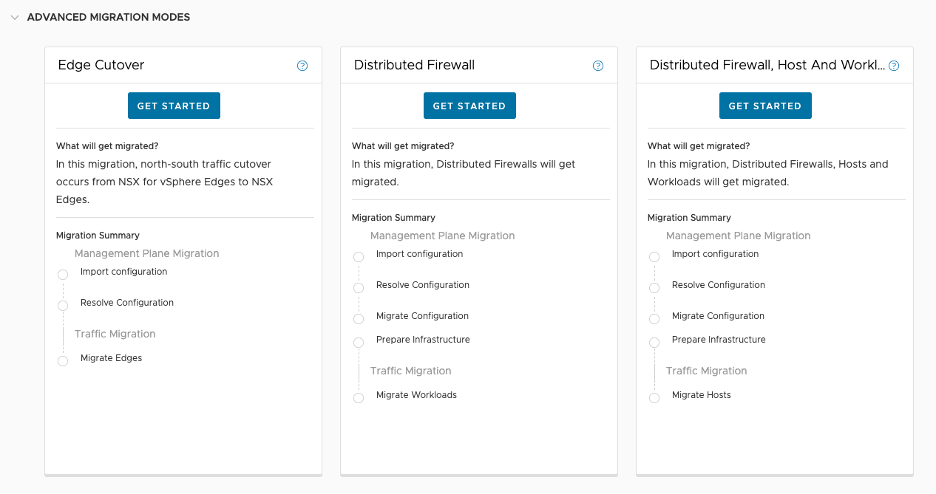Migration Coordinator is a fully supported free tool that is built into NSX Data Center to help migrate from NSX for vSphere to NSX (aka NSX-T). Migration Coordinator was first introduced in NSX-T 2.4 with a couple of modes to enable migrations. Through customer conversations over the years, we’ve worked to expand what can be done with Migration Coordinator. Today, Migration Coordinator supports over 10 different ways to migrate from NSX for vSphere to NSX.
In this blog series, we will look at the available migration approaches and the prep work involved with each. This blog series should help choose, from multiple different angles, the right mode to choose for migrating from NSX for vSphere to NSX.
- 3 Standard Migration Modes

- 3 Advanced Migration Modes

- 3 More Modes Available Under User Defined Topology

- Lastly, 2 more Modes Dedicated to Cross-VC to Federation and available on NSX Global Manager UI

Some of these modes take a cookie-cutter approach and require very little prep work to migrate while others allow you to customize the migration to suit their needs. In this blog, we will take a high level look at these modes.
Migration Coordinator Approaches
At a high level, Migration Coordinator supports two kinds of migration approaches.
- In-Place
- Lift and Shift
In-Place Migration
In-place migrations modes migrate from NSX for vSphere to NSX, using the same hardware that NSX for vSphere is running on. In this migration mode, there is no requirement to bring in new hardware. If there is enough capacity to run the required NSX infrastructure—such as the NSX managers, edges, and more—Migration Coordinator can be used.
Config migration
These modes generally migrate everything, configuration, and workloads. One exception is the mode, “Distributed Firewall, Host and Workload Mode”, which is preferred by customers who only want to migrate the Distributed Firewall-related configuration and not the entire configuration.
Workload migration
In the In-Place migration modes, Migration Coordinator takes care of moving the workloads from NSX for vSphere to NSX. There is no need for a separate tool or approach for workload migration. These modes also support a built-in mechanism that allows workloads on the NSX for vSphere to talk to workloads on NSX, during the migration. This mode doesn’t need to create any bridges between the two environments, NSX for vSphere and NSX.
Bridging
Customers with smaller deployments may be able to migrate everything in a single maintenance window. For those with larger deployments, migration may take a longer time with workloads spread across both NSX for vSphere and NSX. Migration coordinator’s In-Place migration modes allow the workloads to talk to each other without any drop in either network connectivity or security posture.
In these modes, Migration Coordinator fully controls the timing of the actual workload migration. While this approach has been leveraged by many customers, some who are dealing with multiple tenants with their own timings may prefer granular control over when a workload is migrated. For such use cases, check the second high-level approach of migration, lift, and shift.
Lift and Shift Migration
Lift and shift migration modes migrate NSX for vSphere from one set of hardware to a new NSX instance that’s installed on a completely different set of hardware which may be new or repurposed from NSX for vSphere. These modes are generally preferred by those who are in the middle of a hardware refresh cycle or prefer to have granular control over when each workload is migrated and the northbound connectivity and design.
Configuration migration
These modes migrate the configuration of T0s and the NSX entities such as DFW rules that are south of T0s. Northbound configuration of NSX—i.e. BGP connectivity, etc.—should be prepared by the users in advance, before running the migration leveraging Migration Coordinator.
Workload migration
In these modes, Migration Coordinator does not migrate the workloads. In all of the modes, you will be able to migrate the workloads using vMotion. In one specific mode discussed later in this blog, “User Defined Topology: Configuration and Edge Migration Mode,” the user has the choice to either leverage vMotion or HCX.
Bridging
In the lift and shift modes, one may need to set up a bridge using either NSX bridge or HCX to ensure there is no drop in network connectivity during migration. This depends on the duration of the migration.
Migration Modes
With that intro, the following are the migration modes available with Migration Coordinator under the two high-level approaches of (1) In-Place and (2) Lift and Shift.
In-Place Modes
- NSX for vSphere: Fixed Topology
- NSX for vSphere with vRealize Automation:
- Is similar in approach to the first mode, “NSX for vSphere: Fixed Topology” but with a lock-step approach with vRA.
- Distributed Firewall, Host, and Workload
- NSX for vSphere: User-Defined Topology – Complete migration
- NSX Global Manager: User-Defined Topology – Complete migration
Lift and Shift Modes
- Distributed Firewall
- NSX for vSphere: User-Defined Topology – Configuration migration
- NSX for vSphere: User-Defined Topology – Configuration and Edge migration
- NSX Global Manager: User-Defined Topology – Configuration migration
Stay tuned for more blogs of this V2T migration series, in which we will take a closer look at the above modes and review the pros and cons of leveraging these modes.
Resources
Want to learn more? Check out the following resources:
- Migration Coordinator Documentation:
- Design Guide
- Try out NSX


Comments
0 Comments have been added so far